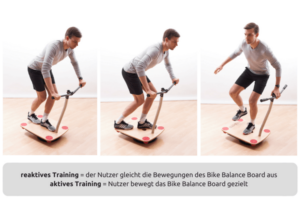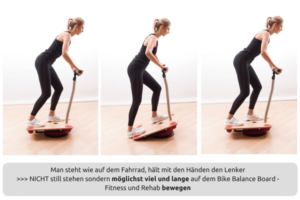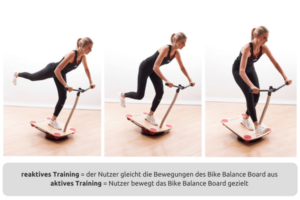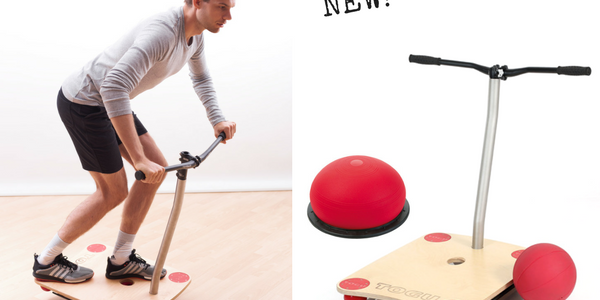The training device for improving postural and motor control
What will be improved by training with the Bike Balance Board – fitness and rehab?
- Improvement of postural control
- The ability to maintain an upright posture or to restore it after balance disturbances (balance regulation). (= reactive training – user balances the movements of the Bike Balance Board)
- Good postural control prevents the most common pain in the musculoskeletal system (source Rasev [1])
- Improvement of motor control
- The ability to plan, coordinate and execute a movement (target motor skills). (= active training – user makes specific moves with the Bike Balance Board)
- Good motor control means agility and enjoyment of exercise in everyday life

Why is the Bike Balance Board – fitness and rehab particularly suitable for improving postural and motor control?
- For postural and motor control, the muscles in the pelvis and trunk area are important
- The Bike Balance Board especially activates the muscles in the pelvic and torso area and stimulates their coordination, as the hands grip a holding bar (handlebar) and are thus ‘fixed’. As a result, the movements of the user come from the pelvic and trunk area
- The handlebar makes the Bike Balance Board a great training tool for improving postural and motor control

What is special about training with the Bike Balance Board – fitness and rehab?
- Training with the Bike Balance Board reduces the monotony in people’s daily routines and counteracts a cause of the most common pain in the musculoskeletal systemThe Bike Balance Board brings new motion experiences to the user, because new, unfamiliar to the user movements are executed. The new experiences of movement counteract monotony in the movements of people in their everyday life. The monotony in the movements is a cause of the most common musculoskeletal pain. (Source Rasev [1])
- The new moves learned with the Bike Balance Board are also available in emergency or panic situationsWith the new movement experiences through the application of the Bike Balance Board learning processes are initiated in the brain, which lead to an extension of the so-called motor and sensor maps (source: Beck), which in turn lead to the newly learned movements as Subcortical programs are available (source: Rasev [1]). This allows the newly learned movements to be performed without conscious thought, and is also available in situations where movement needs to be performed very quickly, such as in emergency or panic situations.

What is being trained with the Bike Balance Board – fitness and rehab?
- Sense of balance and proprioception (refers to the perception of body movement and position in space [2] or the position of individual body parts to each other [3].)
Sources:
[1] E. Rasev: Das Konzept der posturalen Therapie in der Schmerztherapie des Facharztes für PRM bei den häufigsten Schmerzen im Bewegungsapparat, Berlin 2012, Beitrag anlässlich der 117. Jahrestagung der Deutschen Gesellschaft für Physikalische Medizin und Rehabilitation; zitiert aus Physikalische Medizin, Rehabilitationsmedizin, Kurortmedizin, Thieme Verlag Stuttgart, Ausgabe 04, 2012, veröffentlicht online https://www.thieme-connect.com/products/ejournals/abstract/10.1055/s-0032-1322857#ID_57_1
[2] K. Buser u. a.: Kurzlehrbuch medizinische Psychologie- medizinische Soziologie, Urban&FischerVerlag, 2007, S. 93, ISBN 3-437-43211-7, zitiert bei Wikipedia
[3] C. Kirschbaum: Biopsychologie von A bis Z, Springer Berlin Heidelberg; 1. Auflage 2008, ISBN 3-540-39603-9 – zitiert bei Wikipedia
[4] F. Beck: Sport macht schlau: Mit der Hirnforschung zu geistiger und sportlicher Höchstleistung, Goldegg Verlag Berlin, 2014, S. 131ff, ISBN: 9783902991188
Author: Markus Braun, DMB







